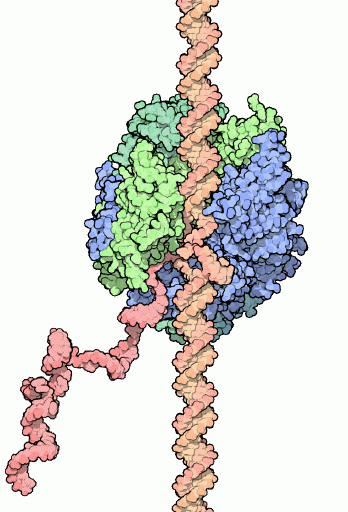|
Inhaltsübersicht | Nanomaschinen | Moleküle | Programme | Kurse | Fun | Links |
||
| > |
RNA-Polymerase

Not Just for Messages
RNA is a versatile molecule. In its most familiar role, RNA acts as an intermediary, carrying genetic information from the DNA to the machinery of protein synthesis. RNA also plays more active roles, performing many of the catalytic and recognition functions normally reserved for proteins. In fact, most of the RNA in cells is found in ribosomes--our protein-synthesizing machines--and the transfer RNA molecules used to add each new amino acid to growing proteins. In addition, countless small RNA molecules are involved in regulating, processing and disposing of the constant traffic of messenger RNA. The enzyme RNA polymerase carries the weighty responsibility of creating all of these different RNA molecules.The RNA Factory
RNA polymerase is a huge factory with many moving parts. The one shown here, from PDB entry 1i6h, is from yeast cells. It is composed of a dozen different proteins. Together, they form a machine that surrounds DNA strands, unwinds them, and builds an RNA strand based on the information held inside the DNA. Once the enzyme gets started, RNA polymerase marches confidently along the DNA copying RNA strands thousands of nucleotides long.Accuracy
As you might expect, RNA polymerase needs to be accurate in its copying of genetic information. To improve its accuracy, it performs a simple proofreading step as it builds an RNA strand. The active site is designed to be able to remove nucleotides as well as add them to the growing strand. The enzyme tends to hover around mismatched nucleotides longer than properly added ones, giving the enzyme time to remove them. This process is somewhat wasteful, since proper nucleotides are also occasionally removed, but this is a small price to pay for creating better RNA transcripts. Overall, RNA polymerase makes an error about once in 10,000 nucleotides added, or about once per RNA strand created.Next: Poisoning Polymerase
Last changed by: A.Honegger,